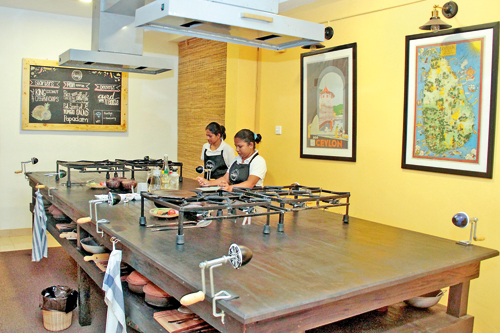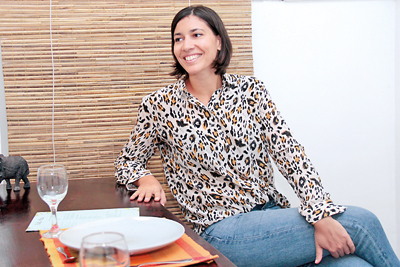Cooking up Aunty’s favourite Lankan fare

Udani and Ishani: Demonstrating exactly how it’s done
Strains of old Sinhala songs greet your ears as you walk into a little renovated home nestled down Nelson Lane, Kollupitiya with the blackboard saying ‘Aunty’s
Sri Lankan Cooking Class’. As you enter the verandah, you can see a grinding stone (the miris gala), winnowing fans (kulla) and coconut cleavers arranged on a table with a small couch on the opposite side.
The wall painted a welcoming yellow is adorned with posters about Sri Lanka. There are black aprons embroidered with their logo waiting to be worn under a shelf of spices and eco-friendly products (such as bamboo straws) offered on sale by the cooking class. A large table equipped with coconut scrapers, stoves and fume hoods is where the magic happens.
‘Aunty’s Sri Lankan Cooking Class’ which began early this year was launched by Swedish-born Sanna Khaled who has been living in Sri Lanka for the past six years. Quickly gaining momentum on social media and by word-of-mouth, the Cooking Class has become a local and tourist favourite as experiences go.
As a person who enjoyed cooking immensely, Sanna sought help from her friends and mostly her friends’ mothers (hence the name of the place) to learn how to make Sri Lankan food. “I thought there would be more people like me who don’t know how to cook. They come here, live here and they eat the food but they never really learn how to make the food,” she says on how the idea came about to start the class.
It was also the lack of activities for tourists within Colombo that pushed Sanna into renovating a house and beginning the class. It is not just the basic rice and curry that is taught, but different menus can be chosen; from hoppers to milk rice (kiribath), lamprais and hot butter cuttlefish, you can pick whichever menu appeals. There is even a special class every last weekend of the month where a new menu is introduced.
“I wanted something that both locals and tourists could come and enjoy which could also be very family-oriented. Our menu is for those who are very new to Sri Lankan cooking and for locals who want to make things such as bites and hoppers,” she explains.

Sanna: Bringing Lankan cuisine to a wider audience. Pix by Indika Handuwala
There are market and street food tours where you are also taken to the market to buy the ingredients for the class and where you can try the street food on offer in the city.
Although she may know the basics Sanna leaves the cooking to Ishani Phillips and Udani Liyanagamage who are the two instructors for the cooking classes.
They take us to the cooking stations where we are given our aprons and a glass of iced tea. They tell us that we will be making Kottu (a personal favourite) from scratch and begin to explain the origin of the dish.
“Kottu is known as the musical street food because of the noise that is made when it’s being cooked,” Ishani tells us referring to the metal clang of the roti being diced and mixed as we knead flour, water, coconut oil and salt into six balls of dough that would later become Godhamba roti. These are kept to rest in a container of oil.
Next we add assorted spices into diced chicken, leaving it to marinate as little nuggets of wisdom are imparted to us by Ishani about the difference between roasted and unroasted curry powder.
After frying our chicken and dividing it for a curry, we take out a clay pot. Adding oil, we begin to fry our spices from mustard seeds, pandan leaves (rampe), chili powder and more before adding the coconut milk and chicken.
After our chicken has been prepared and set aside, we take out our roti that had expanded and is looking a little smoother than when we left it. Using a rolling pin, we flatten the dough balls into roti and are reassured that it is okay that it looks uneven as we are going to chop it up for the kottu anyway.
With our roti roasted and cut and our chicken ready, in another pan we temper some vegetables and egg before adding the roti strips. Then we pour the chicken curry over half our kottu and the other half we mix with a cheese sauce and fried chicken.
All done! Our plates of chicken cheese kottu and curry chicken kottu are ready. It was definitely an experience that we thoroughly enjoyed!
Aunty’s cooking class is Rs. 7900 per head including a welcome drink, snacks, desserts and recipes.
Located at 39/28 Nelson Lane, Colombo 3, they are open every day of the week and have a lunch class and a dinner class available for booking. You can reach them on their Instagram @auntys_srilankan_cooking_class, by emailing hello@auntys.lk or contacting
076 694 1540.


